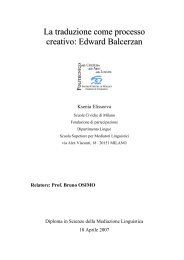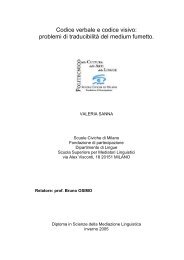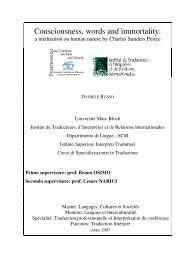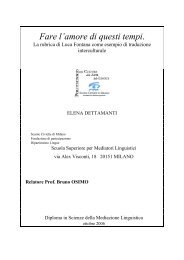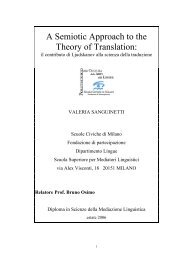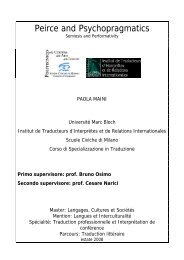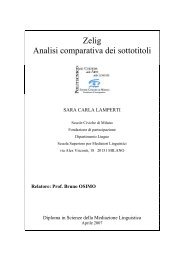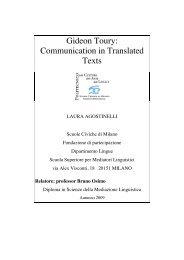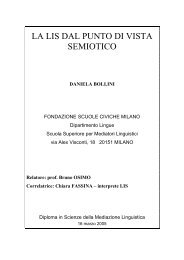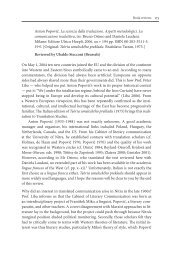Ksenia Elisseeva - Bruno Osimo, traduzioni, semiotica della ...
Ksenia Elisseeva - Bruno Osimo, traduzioni, semiotica della ...
Ksenia Elisseeva - Bruno Osimo, traduzioni, semiotica della ...
Create successful ePaper yourself
Turn your PDF publications into a flip-book with our unique Google optimized e-Paper software.
2.2. Relations.<br />
Chess<br />
Language<br />
2.2.1. The interaction between the 2.2.1. Syntagmatics: valent<br />
saturation of valence 1<br />
pieces: the correlation between the connections between words<br />
strength and number of attacking and<br />
defending pieces, “the coefficient of<br />
tension” in the main zones of play, the<br />
2.2.2. Recollection of previous moves,<br />
for instance in connection with the rule<br />
about threefold repetition of a position,<br />
and especially of possible future<br />
positions. The question is not so much<br />
that of the positions themselves as of<br />
their configurational traits. (See 2.1.3.)<br />
2.2.3. A specific instance of the<br />
preceding is the relation between<br />
abridging the position and isolating<br />
support configurations: the pawn<br />
backbone, open lines, pawn superiority<br />
on the flank, bishops of opposite colors,<br />
etc. Ability to abridge the position makes<br />
it possible to foresee the situation for<br />
many moves in advance, which is not<br />
possible with a full set of pieces.<br />
2.2.2. Paradigmatics: recollection of<br />
connections between words and<br />
sentences not present in the text<br />
2.2.3. Abridging sentences to initial<br />
words, usually to the predicate, is a<br />
special type of relation in a<br />
sentence, as is abridging each<br />
dependent cluster to a single word,<br />
usually a pronoun. This abridgment<br />
makes it possible to reduce all the<br />
diverse formations of the sentence<br />
to a finite number of equivalent<br />
classes, and thus, according to<br />
Donald Michael's theorem, to<br />
conceive of language as the<br />
product of a finite automaton.<br />
2.3. Operations.<br />
Applying the relations mentioned in 2.2. and other possible relations in<br />
order to achieve an objective makes it possible to speak of combinations of<br />
relations.<br />
1 The valence of a chess piece means the number of squares that it can attack; the<br />
valence is saturated if sufficiently valuable pieces of the opponent stand on these squares.<br />
From our viewpoint, it was precisely valences that were formalized in previously proposed<br />
models of the game of chess.<br />
40



